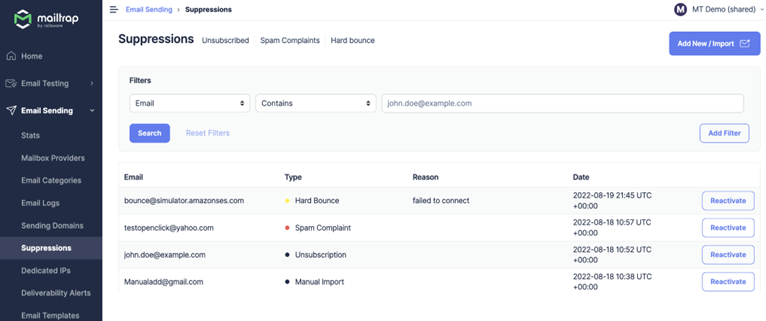As an email marketer, you must maintain good email list hygiene. Failing to do so can lead to bounces, complaints and poor deliverability overall. Also, ignoring unsubscribe requests and spam complaints can lead to legal issues and damage to a company's reputation.
Email suppression lists can help prevent all those challenges.
So what are email suppression lists, why do they matter, and how can they help you comply with email marketing regulations?
What Are Email Suppression Lists?
Email suppression lists consist of email addresses that have previously requested to not receive emails from a particular sender, such as your brand.
Sending emails to people who no longer want to hear from you can result in various problems:
- Complaints, when recipients mark your marketing emails as spam or junk
- Bounces, when the email address is no longer valid, the recipient's mailbox is full, or the email server is down
- Decreased email sender reputation, which hurts the deliverability of your future emails
Running suppression lists as a part of your email marketing strategy helps reduce the chance of complaints, bounces, and negative impacts on your sender reputation and deliverability.
Email Suppression Lists and the Law
Email marketing is subject to laws and regulations in many countries, often requiring marketers to obtain consent from recipients before sending commercial emails.
For instance, GDPR regulates data protection and privacy for citizens of the European Union. It applies to all businesses processing personal data from EU citizens, regardless of the company's location.
Because GDPR requires companies to process data purposefully, companies have to obtain explicit consent from people before sending marketing emails. And once someone opts out or withdraws consent, that person's data must be suppressed.
In the United States, the CAN-SPAM Act requires marketers to include an easy opt-out method in their emails and to respect opt-out requests. It applies to all businesses sending commercial emails to US recipients. Principles of CAN-SPAM include unsubscribe option requirements, sender identification requirements, and the requirement to include the sender's valid physical postal address.
As with GDPR, email suppression lists play a crucial role in helping companies comply with CAN-SPAM's opt-out requirements, avoid penalties for noncompliance, and ensure that they maintain their audiences' trust.
Neglecting to use email suppression lists can result in legal problems and harm your company's reputation.
Emails to Add to Your Suppression List
So, you've learned that building an email suppression list is an important step in compliant email marketing. Now, let's discuss what emails to add as a part of your suppression list management.
- Unsubscribed emails: Recipients who have requested to opt-out or unsubscribe from receiving your emails
- Bounced emails: Addresses that have previously bounced or failed to deliver successfully, which may be because the email address is no longer valid or that the address has been deactivated
- Complaint emails: Addresses that have marked your emails as spam or have lodged a complaint against your emails
- Inactive emails: Recipients who haven't engaged with your emails for more than six months, which may indicate that the recipient is no longer interested in your emails or that the email address is no longer in use
 Source: Mailtrap
Source: Mailtrap
How to Build an Email Suppression List
Now you know what emails to include on a suppression list. Let's go over the steps of how to create one.
- Identify the sources of suppression data: Include recipients who have opted out or unsubscribed, marked your emails as spam, or requested their data be deleted, among other possibilities.
- Collect the data: Collect those email addresses and any other identifying information for recipients who have requested not to receive your emails.
- Implement the suppression list: Upload the suppression list to your email marketing software and configure your email campaigns to exclude any email addresses on the list.
- Ensure compliance with laws and regulations: Run the list according to the CAN-SPAM Act and GDPR, or any other regulations in your country.
- Manage your suppression list: Regularly update the suppression list to reflect changes in a recipient's status, as when someone who has previously opted out opts back in.
Using those steps, you can create an effective suppression list that helps you comply with laws and regulations, protect your company's reputation, and enjoy the pros of email marketing by maintaining high email deliverability.
Tools That Automatically Maintain Suppression Lists
Many email marketing platforms allow the setup of automatic email suppression list management. Here are some popular options:
- HubSpot: A well-recognized, averagely priced, all-in-one marketing automation platform that includes various email marketing features, including automatic email suppression list management ($18/month for the Starter plan)
- Brevo (formerly Sendinblue): Another all-in-one marketing platform offering an automatic email suppression list management among other email marketing features; the most expensive one in this list ($25/month for the Starter plan)
- Mailtrap: An email API/SMTP service (note: I work at Mailtrap) that provides an automatic email address suppression feature ($10/month for the individual plan)
Of course, some platforms offer more advanced features than others, so it's important to evaluate your needs and choose a platform that meets them best.
If you happen to change your marketing software, migrate your suppression lists, too. That will prevent invalid or bounced emails from being added back to your email list and included in future email campaigns. You'll keep your recipient list consistent and reliable throughout any changes in your marketing.
Other Tips for Improving Email List Hygiene
Although email suppression lists are important for maintaining email list hygiene, it's also helpful to keep the size of your email list as small as possible. Here are some additional tips to make sure you don't get to add a lot of suppressed email addresses to your list.
Email Validation
Validating email addresses before adding them to your email list prevents invalid and bounced email addresses from hurting your email deliverability. Regularly move invalid and bounced emails from your email list to your email suppression list to target your campaigns at the right recipients.
Opt-Outs
Providing clear and easy-to-find opt-out options may also be useful in preventing subscribers from marking your emails as spam or lodging a complaint against your emails. Ideally, the opt-out process should be simple to spot in the email and should take no more than two steps to complete. Opt-outs also help you comply with legal requirements, such as GDPR and CAN-SPAM.
Loyalty of Recipients
Keeping subscribers engaged and interested in your emails will likely reduce the number of opt-outs and complaints. To engage your audience, segment and target them with personalized content. Loyalty programs, as well as high-quality communication overall, can attract their attention to your emails.
* * *
Now you know what an email suppression list is and why it's vital for keeping your email lists clean and complying with legal regulations. Stick to email list hygiene, use tools to automate suppression lists, and validate your email addresses to make the process easier and more efficient.
More Resources on Email List Hygiene
How to Help Your Email Subscribers Cope With Inbox Stress
Four Types of Email Addresses Damaging Your Deliverability, and What You Can Do About Them




